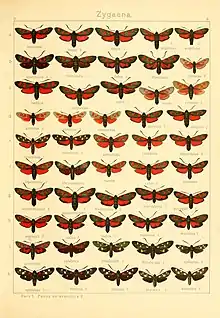Zygaena cynarae
Zygaena cynarae is a species of moth in the Zygaenidae family. It is found from France east to Russia.[1]
| Zygaena cynarae | |
|---|---|
 | |
| Z. c. cynarae and Z. c. turatii in Seitz | |
| Scientific classification | |
| Domain: | Eukaryota |
| Kingdom: | Animalia |
| Phylum: | Arthropoda |
| Class: | Insecta |
| Order: | Lepidoptera |
| Family: | Zygaenidae |
| Genus: | Zygaena |
| Species: | Z. cynarae |
| Binomial name | |
| Zygaena cynarae (Esper, 1789) | |
| Synonyms | |
| |
It is a large Zygaena with translucent wings with oval or rounded red spots. The anterior median spot is well developed. The basal posterior and median posterior spots are large and linked with a red line which can be missing in some specimens. The wingspan is about 30–31 mm.[2]
Technical description and variation (Seitz)
Z. cynarae Exp. (= millefolii Esp.) 5-spotted, the body entirely without hairs, with metallic green gloss; wings very sparsely scaled, the colour appearing pale. The abdomen bears a red ring which is more distinct at the sides than above. In ab. turatii Stdf. [now subspecies] the abdominal belt is entirely missing above, appearing only as a lateral spot; North Italy, Dalmatia; near Pegli, at the Riviera, I met constantly with this form, while it occurs elsewhere only sparingly among the type-form. — ab. tricingulata Burgeff [ synonym of cynarae ] has 3 abdominal belts, which, however, are usually red only above and laterally, not below. —. In genistae H.-Sch. (= dahurica H.-Sch. ), from South France, Hungary and the Tyrol, the forewing is paler and more transparent. — centaureae Fisch.-Wald. [now full species Zygaena centaureae ] has a stronger antenna and the 5th spot is prolonged towards the hind angle. — Larva greenish above, yellowish grey at the sides ; subdorsal black dots, near which there are yellow spots; head greyish green.[3]
Biology
Adults are on wing from mid May to July.
The larvae feed on Peucedanum species, including Peucedanum cervaria.[4] Part of the larvae overwinter multiple times. Full-grown larvae can be found from April to the beginning of June.
It is a very local and sedentary species, which requires dense colonies of its hostplant. They are sluggish and clumsy insects; the individuals occur more singly, there being apparently no decided flight-places as is the case with other Burnets.
Subspecies
- Zygaena cynarae cynarae
- Zygaena cynarae adriatica Burgeff, 1926
- Zygaena cynarae florianii Dujardin, 1965
- Zygaena cynarae franconica Holik, 1936
- Zygaena cynarae goberti Le Charles, 1952
- Zygaena cynarae jadovnika Rauch, 1977
- Zygaena cynarae samarensis Holik, 1939
- Zygaena cynarae tolmezzana Meier, 1957
- Zygaena cynarae turatii Standfuss, 1892
- Zygaena cynarae tusca Verity, 1930
- Zygaena cynarae vallettensis Reiss, 1958
- Zygaena cynarae waltharii Burgeff, 1926
References
- Fauna Europaea
- lepiforum.de
- Seitz, A., 1913, in Seitz, Gross-Schmett. Erde 6: 22.,The Macrolepidoptera of the Palearctic Fauna 2. Volume: The Palearctic Bombyces & Sphinges. pdf
 This article incorporates text from this source, which is in the public domain.
This article incorporates text from this source, which is in the public domain. - Schmetterlinge und ihre Ökologie